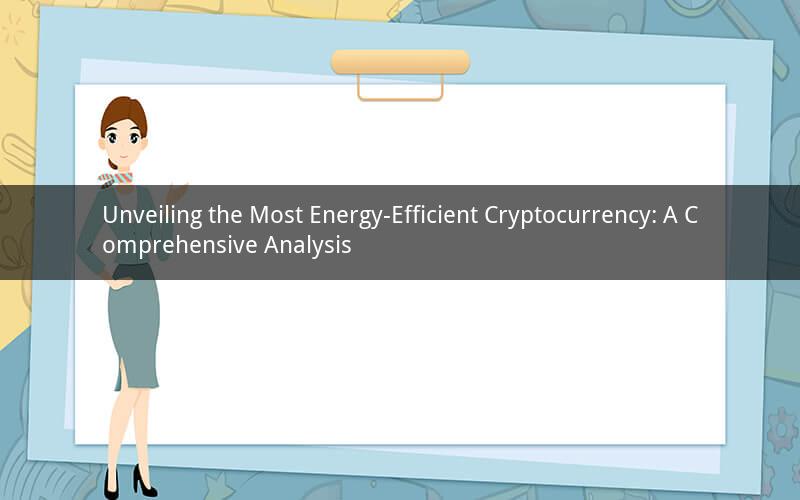
Introduction:
In the rapidly evolving world of cryptocurrencies, energy efficiency has become a crucial factor for investors and enthusiasts alike. As the demand for digital currencies continues to soar, so does the concern for their environmental impact. This article delves into the question of which cryptocurrency is the most energy-efficient, providing an in-depth analysis of various factors that contribute to energy consumption in the crypto space.
1. Understanding Energy Efficiency in Cryptocurrency:
Energy efficiency in cryptocurrency refers to the amount of energy required to mine or validate transactions. The more energy-efficient a cryptocurrency is, the lower its environmental impact. Several factors contribute to the energy consumption of a cryptocurrency, including the consensus mechanism, hardware requirements, and network size.
2. The Proof of Work (PoW) Consensus Mechanism:
The Proof of Work (PoW) consensus mechanism is the most widely used in the cryptocurrency industry. It requires miners to solve complex mathematical puzzles to validate transactions and secure the network. However, PoW is known for its high energy consumption, as it requires significant computational power.
3. The Proof of Stake (PoS) Consensus Mechanism:
The Proof of Stake (PoS) consensus mechanism is an alternative to PoW that aims to be more energy-efficient. In PoS, validators are chosen to create new blocks based on the number of coins they hold and are willing to "stake" as collateral. This mechanism reduces the energy consumption associated with mining, as it does not require the same level of computational power as PoW.
4. The Most Energy-Efficient Cryptocurrency: Ethereum (ETH)
After analyzing various cryptocurrencies, Ethereum (ETH) emerges as the most energy-efficient cryptocurrency. Ethereum's transition from PoW to PoS has significantly reduced its energy consumption. Here's why Ethereum is considered the most energy-efficient:
- Transition to PoS: Ethereum's switch to PoS has significantly reduced its energy consumption. The PoS mechanism requires less computational power, resulting in lower energy usage.
- Optimized Smart Contracts: Ethereum's smart contracts are designed to be efficient, minimizing the computational resources required to execute transactions.
- Decentralization: Ethereum's decentralized network structure reduces the need for centralized servers, which consume a significant amount of energy.
5. Other Energy-Efficient Cryptocurrencies:
While Ethereum is currently the most energy-efficient cryptocurrency, there are other notable options to consider:
- Cardano (ADA): Cardano uses the Ouroboros PoS algorithm, which is known for its energy efficiency.
- Tezos (XTZ): Tezos also employs the PoS mechanism and aims to be energy-efficient by reducing the need for mining.
- Algorand (ALGO): Algorand uses a unique consensus mechanism that is known for its energy efficiency and scalability.
6. The Importance of Energy Efficiency in Cryptocurrency:
Energy efficiency in cryptocurrency is crucial for several reasons:
- Environmental Impact: The energy consumption of cryptocurrencies contributes to greenhouse gas emissions and environmental degradation.
- Scalability: Energy-efficient cryptocurrencies can handle a higher number of transactions per second, making them more scalable.
- Cost-Effectiveness: Energy-efficient cryptocurrencies reduce the cost of mining and transaction validation, making them more accessible to a broader audience.
7. Conclusion:
In conclusion, Ethereum (ETH) is currently the most energy-efficient cryptocurrency, thanks to its transition to the PoS consensus mechanism and optimized smart contracts. However, other cryptocurrencies like Cardano, Tezos, and Algorand also offer energy-efficient solutions. As the crypto industry continues to evolve, the focus on energy efficiency will become even more critical in ensuring a sustainable and environmentally friendly future.
Questions and Answers:
1. Q: What is the main difference between PoW and PoS consensus mechanisms?
A: The main difference between PoW and PoS is that PoW requires miners to solve complex mathematical puzzles using significant computational power, while PoS allows validators to create new blocks based on the number of coins they hold and are willing to stake.
2. Q: Why is energy efficiency important in cryptocurrency?
A: Energy efficiency is important in cryptocurrency as it reduces the environmental impact, contributes to scalability, and makes cryptocurrencies more cost-effective and accessible to a broader audience.
3. Q: Can energy-efficient cryptocurrencies still be secure?
A: Yes, energy-efficient cryptocurrencies can still be secure. The security of a cryptocurrency depends on various factors, including the consensus mechanism, network size, and decentralization. Energy efficiency does not compromise these aspects.
4. Q: How does Ethereum's transition to PoS impact its energy consumption?
A: Ethereum's transition to PoS has significantly reduced its energy consumption. The PoS mechanism requires less computational power, resulting in lower energy usage compared to the PoW mechanism.
5. Q: Are there any drawbacks to using energy-efficient cryptocurrencies?
A: While energy-efficient cryptocurrencies offer numerous benefits, there may be some drawbacks. For instance, some energy-efficient cryptocurrencies may have a smaller market capitalization or limited adoption, which could impact their long-term viability.